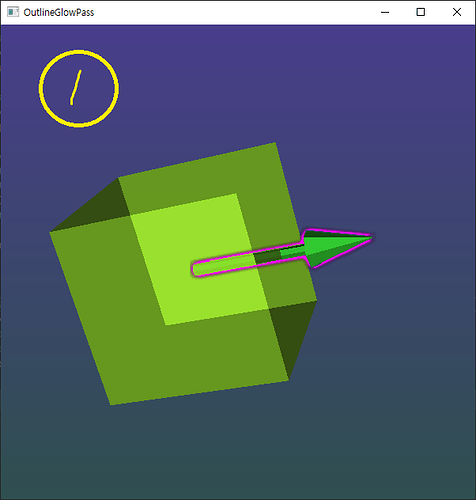#include <vtkActor.h>
#include <vtkCubeSource.h>
#include <vtkArrowSource.h>
#include <vtkCamera.h>
#include <vtkNamedColors.h>
#include <vtkNew.h>
#include <vtkOpenGLRenderer.h>
#include <vtkOutlineGlowPass.h>
#include <vtkPolyDataMapper.h>
#include <vtkProperty.h>
#include <vtkRenderStepsPass.h>
#include <vtkRenderWindow.h>
#include <vtkRenderWindowInteractor.h>
#include <vtkSmartPointer.h>
#include <vtkVersion.h>
#include <iomanip>
#include <iostream>
#include <string>
namespace {
/**
* Check the VTK version.
*
* @param major: Major version.
* @param major: Minor version.
* @param major: Build version.
*
* @return True if the requested VTK version is greater or equal to the actual
* VTK version.
*/
bool VTKVersionOk(unsigned long long const& major,
unsigned long long const& minor,
unsigned long long const& build);
} // namespace
int main(int, char*[])
{
if (!VTKVersionOk(9, 0, 20200909))
{
std::cerr
<< "You need VTK version 9.0.20200909 or greater to run this program."
<< std::endl;
return EXIT_FAILURE;
}
vtkNew<vtkNamedColors> colors;
vtkNew<vtkRenderWindowInteractor> iren;
vtkNew<vtkRenderWindow> renWin;
renWin->SetMultiSamples(0);
iren->SetRenderWindow(renWin);
// Set up the renderers.
// One for the object and the other for the outline.
vtkNew<vtkRenderer> renderer;
vtkNew<vtkRenderer> rendererOutline;
rendererOutline->SetLayer(1);
renWin->SetNumberOfLayers(2);
renWin->AddRenderer(rendererOutline);
renWin->AddRenderer(renderer);
// Create an cone.
vtkNew<vtkCubeSource> cubeSource;
cubeSource->Update();
// Create mapper and actor for the main renderer.
vtkNew<vtkPolyDataMapper> cubeMapperMain;
cubeMapperMain->SetInputConnection(cubeSource->GetOutputPort());
vtkNew<vtkActor> cubeActorMain;
cubeActorMain->SetMapper(cubeMapperMain);
cubeActorMain->GetProperty()->SetDiffuseColor(
colors->GetColor3d("green_yellow").GetData());
cubeActorMain->GetProperty()->SetOpacity(0.8);
renderer->AddActor(cubeActorMain);
// Create an arrow.
vtkNew<vtkArrowSource> arrowSource;
// arrowSource->SetShaftRadius(1.0);
// arrowSource->SetTipLength(1.0);
arrowSource->Update();
// Create mapper and actor for the main renderer.
vtkNew<vtkPolyDataMapper> arrowMapperMain;
arrowMapperMain->SetInputConnection(arrowSource->GetOutputPort());
vtkNew<vtkActor> arrowActorMain;
arrowActorMain->SetMapper(arrowMapperMain);
arrowActorMain->GetProperty()->SetDiffuseColor(
colors->GetColor3d("LimeGreen").GetData());
renderer->AddActor(arrowActorMain);
// Lets make the outline glow!
// Create the render pass.
vtkNew<vtkRenderStepsPass> basicPasses;
vtkNew<vtkOutlineGlowPass> glowPass;
glowPass->SetDelegatePass(basicPasses);
// Apply the render pass to the highlight renderer.
rendererOutline->SetPass(glowPass);
// Create mapper and actor for the outline.
vtkNew<vtkPolyDataMapper> arrowMapperOutline;
arrowMapperOutline->SetInputConnection(arrowSource->GetOutputPort());
vtkNew<vtkActor> arrowActorOutline;
arrowActorOutline->SetMapper(arrowMapperOutline);
arrowActorOutline->GetProperty()->SetColor(
colors->GetColor3d("Magenta").GetData());
arrowActorOutline->GetProperty()->LightingOff();
rendererOutline->AddActor(arrowActorOutline);
renWin->SetSize(600, 600);
renderer->GradientBackgroundOn();
renderer->SetBackground(colors->GetColor3d("DarkSlateGray").GetData());
renderer->SetBackground2(colors->GetColor3d("DarkSlateBlue").GetData());
renderer->ResetCamera();
vtkCamera* camera = renderer->GetActiveCamera();
camera->Roll(45.0);
camera->Azimuth(-30.0);
camera->Elevation(-15.0);
renderer->ResetCamera();
// Now set the active camera for the outline.
rendererOutline->SetActiveCamera(camera);
renWin->SetWindowName("OutlineGlowPass");
renWin->Render();
iren->Start();
return EXIT_SUCCESS;
}
namespace {
bool VTKVersionOk(unsigned long long const& major,
unsigned long long const& minor,
unsigned long long const& build)
{
unsigned long long neededVersion =
10000000000ULL * major + 100000000ULL * minor + build;
#ifndef VTK_VERSION_NUMBER
auto ver = vtkSmartPointer<vtkVersion>();
unsigned long long vtk_version_number =
10000000000ULL * ver->GetVTKMajorVersion() +
100000000ULL * ver->GetVTKMinorVersion() + ver->GetVTKBuildVersion();
if (vtk_version_number >= neededVersion)
{
return true;
}
return false;
#else
if (VTK_VERSION_NUMBER >= neededVersion)
{
return true;
}
return false;
#endif
}
} // namespace
I’ve tried implementing a method to display outlines on a polydata object, referring to the example at https://examples.vtk.org/site/Python/Rendering/OutlineGlowPass/.
As shown in [Figure 1], I have successfully rendered the outlines.
Furthermore, I would like to modify the outline of parts of the object that are obscured by other objects. Similar to what is shown in [Figure 2], I want to change the color or adjust the opacity of the obscured parts of the outline.
If there is an easy method to achieve this, I would greatly appreciate your guidance and suggestions. Thank you in advance for your help.

